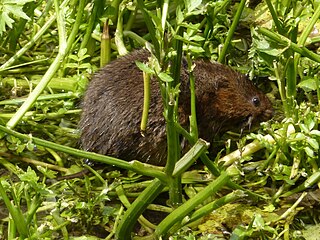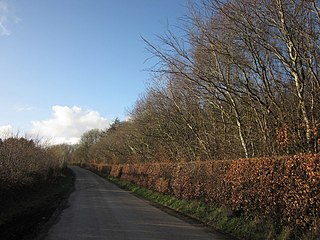Related Research Articles
This article gives an overview of the mire plant communities in the British National Vegetation Classification system.
NVC community H3 is one of the heath communities in the British National Vegetation Classification system. It is one of three communities which are considered transitional between the lowland dry heaths and the wetter communities classified in the NVC as mires.

The United Kingdom Biodiversity Action Plan or (UK BAP) was the UK government's response to the Convention on Biological Diversity, opened for signature at the Rio Earth Summit in 1992. The UK was the first country to produce a national Biodiversity Action Plan. It was published in 1994 and created action plans for priority species and habitats in the UK that were most under threat so as to support their recovery.
NVC community H2 is one of the heath communities in the British National Vegetation Classification system. It is one of five communities categorised as lowland dry heaths.

Yanal Bog is a 1.6 hectare biological Site of Special Scientific Interest on the southern edge of the North Somerset Levels, just north of the village of Sandford, North Somerset. It was notified as an SSSI in 1988.

Briggins Moor is a 15.3 hectare biological Site of Special Scientific Interest in Somerset, notified in 1994. The site is south of Dulverton and close to the border with Devon.

Lambert's Castle is an Iron Age hillfort in the county of Dorset in southwest England. Since 1981 it has been designated as a Site of Special Scientific Interest (SSSI) on account of its geology, archaeology and ecology. The hillfort is designated a scheduled monument together with a bowl barrow, the sites of a post-medieval fair and a telegraph station.
NVC community H4 is one of the heath communities in the British National Vegetation Classification system. It is one of three communities which are considered transitional between the lowland dry heaths and the wetter communities classified in the NVC as mires.
NVC community H5 is one of the heath communities in the British National Vegetation Classification system. It is one of three communities which are considered transitional between the lowland dry heaths and the wetter communities classified in the NVC as mires.
NVC community H6 is one of the heath communities in the British National Vegetation Classification system. It is one of five communities categorised as lowland dry heaths.

Purple moor grass and rush pastures is a type of Biodiversity Action Plan habitat in the UK. It occurs on poorly drained neutral and acidic soils of the lowlands and upland fringe. It is found in the South West of England, especially in Devon.

Frog Wood Bog is a Site of Special Scientific Interest in the Teesdale district of County Durham, England. It lies alongside Bedburn Beck, approximately 3.5 km west of the village of Bedburn.
NVC community M23 is one of the 38 mire communities in the British National Vegetation Classification system.
NVC Community M25 is one of the 38 mire communities in the British National Vegetation Classification system.
NVC Community M27 is one of the 38 mire communities in the British National Vegetation Classification system.
NVC Community M16 is one of the 38 mire communities in the British National Vegetation Classification system.

Caeau Pant-y-Bryn is a Site of Special Scientific Interest (SSSI) in Carmarthenshire, Wales.

Gweunydd Glan-y-glasnant is a Site of Special Scientific Interest (SSSI) in Carmarthenshire, Wales, designated in 1993 for its botanical features.

Wellington College Bog is a 6.2-hectare (15-acre) biological Site of Special Scientific Interest in the grounds of Wellington College on the northern outskirts of Sandhurst in Berkshire.
References
- JNCC Report No. 394 The European context of British Lowland Grasslands J.S. Rodwell1, V. Morgan2, R.G. Jefferson3 & D. Moss4 February 2007 JNCC, Peterborough 2007 ISSN 0963-8091|http://jncc.defra.gov.uk/pdf/jncc394_webpt2v2.pdf
- JNCC National Vegetation Classification field guide to mires and heaths|http://jncc.defra.gov.uk/page-2628